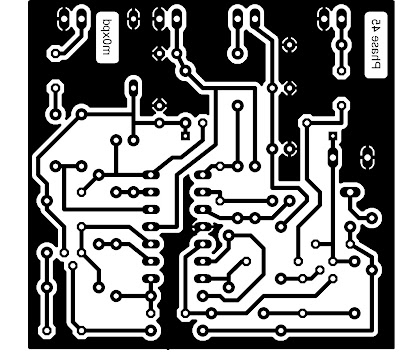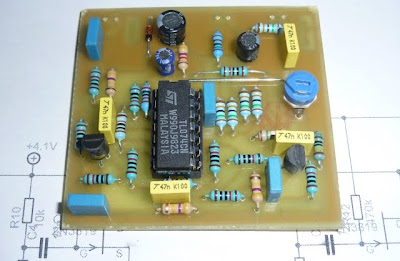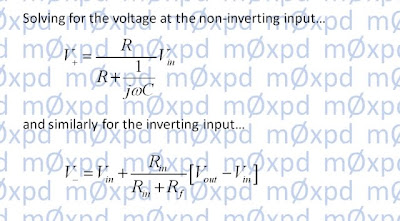Like her ovine eponym before her, Dolly the Tube Screamer has triggered an avalanche of cloning activity. Only a small avalanche. In fact, only one further clone. This time, the object of our sincere flattery is the MXR Phase 45.
I always wanted a phase pedal as a youngster, but somehow never got round to doing anything about it (the m0xpd wallet having been infamously dusty for a very long time). Now, however, flushed with the success of previous stompbox cloning activities, I decided it was time to take the plunge.
You can find the Phase 45 schematic all over the internet (I don't intend to stomp all over MXR's intellectual property by reproducing it here). The junk box dictated that I should replace the original 2n5952s with my default J-FET; the 2n3819. Whilst I was about it, I decided also to replace the two dual op-amps of the original with a single quad package - in my case a TL074 - making the PCB layout simpler...
The red line is a wire link on the component side.
Here's the single copper layer at 600dpi (for my records only - I can't possibly condone any of YOU people making a copy!)...
The assembled PCB looks like this...
It is a very tight squeeze to get it all into a Hammond 1590b-sized box (faithful to the MXR original). To be honest, I had to replace a couple of the caps shown above on the PCB with ceramics on the opposite side - don't tell anybody.
Anyway, after a good deal of cussin' and shoe-hornin', I got it together - here's a POV shot of Dolly the Tube Screamer (right) and her new friend...
The Phase 45 (in common with most similar effects) uses all-pass filter networks (two, in the case of the Phase 45) to achieve the phase shift implied in the name and sums the original and phase shifted signals together. This summation introduces constructive and destructive interference at different frequencies, which are swept around by the action of a low frequency oscillator modulating the phase shift.
In an idle moment, I found myself wondering how the all-pass network works and so, with the popularity (or at least, large number of page hits) of my recent Tube Screamer Analysis ringing in my ears, I decided I'd post the results of that idle speculation...
We start off with the generic active all-pass circuit...
Then we use the potential divider rule to solve for the voltages at the op-amp's inputs...
At this point back in the analysis of the Tube Screamer, I glibly said "the action of the op-amp is to drive the voltage difference at its inputs to zero" (or words to that effect). This time, I'll be slightly less glib and argue that the op-amp multiplies - amplifies ! - the voltage difference between the inputs by a positive constant, "A"...
Now we can do a little algebra to simplify things, before asking what happens if the amplifier gain is very large - in fact, what happens as it approaches infinity. The mathematicians might call this sort of question "limiting behaviour"...
Once again, we'll keep tidying up the algebra and then we'll make the important assumption (as in the MXR Phase 45) that Rf and Rin both equal 10kOhms, in which case some further simplification is possible...
The final result (that result which is published all over the place) is then available after another piece of trivial algebra...
The numerator and denominator of the right-hand side of the equation above (i.e. those bits above and below the horizontal line), being complex conjugates of each other, have equal magnitude frequency response. Therefore, the magnitude response of their ratio is unity (all the changes in the numerator are exactly balanced by equal changes in the denominator). That is to say, all frequency components are unchanged in amplitude as the pass through the all-pass filter - it does what it says on the tin!
However, the network has a non-trivial phase response.
In the Phase 45, this phase response is exploited by implementing "R" in the two cascaded all-pass filter stages by a network including a FET (one of my 2n3819s) in ohmic mode, with its gate voltage (and, so, the equivalent value of "R") modulated at a low frequency. This frequency is controllable by the external "speed control" seen on the original MXR product and on my clone.
I included a shopping link for the Phase 45 above because it really is cheaper to buy one than to build a half-decent copy. By the time you've gathered together all the bits, made a PCB and accounted for your own time at anything above the minimum wage, you have already spent more than the GBP 60 or so they want for a "real" one. Perversely, there will always be a few fools, like yours truly, who prefer to make one just for the interest and the fun of it!
...-.- de m0xpd
Subscribe to:
Post Comments (Atom)











No comments:
Post a Comment